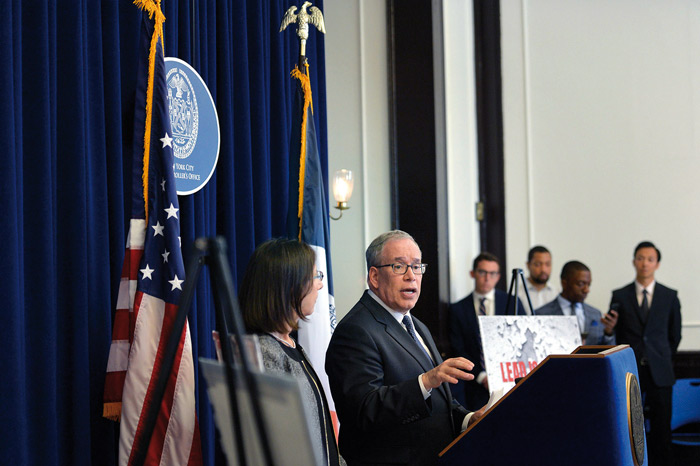Photo Courtesy of Comptroller Stringer’s Office
“The City needs to fully commit to rooting out lead exposure because half measures and haphazard strategies are failing,” Comptroller Stringer said.
By Michael V. Cusenza
Four of the top 15 community districts in the city with the highest numbers of children with elevated blood lead levels are in Queens, according to a scathing investigation released Thursday by City Comptroller Scott Stringer.
Kew Gardens and Woodhaven (820 total number of children with high blood lead levels); Jamaica and Hollis (1,092); Jackson Heights (954); and Elmhurst and Corona (827) made the ignominious ledger, according to Stringer’s probe into child lead exposure in the five boroughs.
Stringer said his new report reveals the “City’s systemic failure to protect children from toxic lead.” The investigation found that City agencies charged with eradicating childhood lead poisoning missed opportunities to protect children by failing to take a proactive approach to prevent lead exposure. Crucial data relating to the location of children with elevated blood lead levels remained siloed in the Department of Health and Mental Hygiene. As a result, over a five-year period, from 2013 through late 2018, the agency empowered to inspect buildings and enforce landlords’ obligations to prevent lead exposure, the Department of Housing Preservation and Development, never performed a lead inspection in 9,671 buildings where 11,972 children tested positive for lead exposure above the federal action level of 5 micrograms per deciliter (mcg/dL). Instead of using the data in DOHMH’s possession to proactively seek out lead exposure hotspots, the City’s lead-inspection regime was hit or miss, and left as many as 63 percent of all buildings under HPD’s jurisdiction with documented cases of child lead exposure entirely uninspected by HPD lead inspectors.
Further, according to Stringer, as many as 2,749 children who lived in the uninspected buildings tested positive for lead exposure after other children in the same buildings tested positive. In fact, 503 buildings under HPD’s jurisdiction that DOHMH data showed had three or more children with blood levels above the 5 mcg/dL CDC action level were never visited by an HPD lead inspector. While the City’s standard lagged behind the federal benchmark at the time and did not explicitly require a City lead inspection unless a child registered a much higher blood lead level of 15 mcg/dL, the City’s own Local Law 1 also set a goal of eliminating and preventing child lead poisoning, and the City had tools available—including relevant data in DOHMH’s possession—that it failed to use to achieve that goal, the comptroller noted.
In response to the investigation’s findings, Stringer called for an across-the-board overhaul of City lead-exposure mitigation and enforcement.
“Any lead poisoning of our children must be treated as a five-alarm fire, but the City isn’t utilizing basic tools at its disposal to extinguish the fires—even in the most problematic buildings it knows about. Nearly 3,000 children tested with elevated blood lead levels after the City was aware of a problem in their buildings. That is an outrage,” Stringer added. “The City needs to fully commit to rooting out lead exposure because half measures and haphazard strategies are failing. Fifteen years ago, New York City set a goal to eliminate childhood lead poisoning once and for all—and for the health and safety of every single child—we must recommit to fulfilling that promise.”

